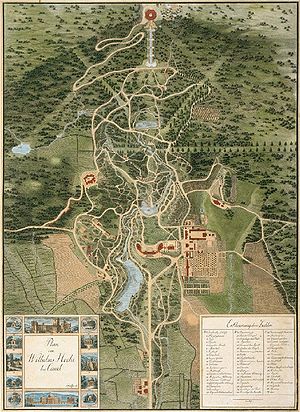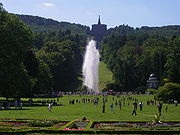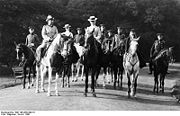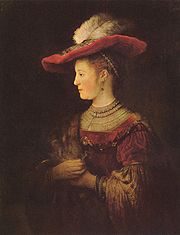
Bergpark Wilhelmshöhe
Encyclopedia

Kassel
Kassel is a town located on the Fulda River in northern Hesse, Germany. It is the administrative seat of the Kassel Regierungsbezirk and the Kreis of the same name and has approximately 195,000 inhabitants.- History :...
, Germany
Germany
Germany , officially the Federal Republic of Germany , is a federal parliamentary republic in Europe. The country consists of 16 states while the capital and largest city is Berlin. Germany covers an area of 357,021 km2 and has a largely temperate seasonal climate...
. Art historian Georg Dehio
Georg Dehio
Georg Gottfried Julius Dehio , was a Baltic German art historian ....
(1850–1932), inspirator of the modern discipline of historic preservation, described the park as "possibly the most grandiose combination of landscape and architecture that the Baroque
Baroque
The Baroque is a period and the style that used exaggerated motion and clear, easily interpreted detail to produce drama, tension, exuberance, and grandeur in sculpture, painting, literature, dance, and music...
dared anywhere" ("vielleicht das Grandioseste, was irgendwo der Barock in Verbindung von Architektur und Landschaft gewagt hat."). The area of the park is 2.4 square kilometres (593.1 acre), making it the largest European hillside park, and second largest park on a mountain slope in the world. Construction of the Bergpark, or "mountain park", began in 1696 and took about 150 years.
History

1696 – 1806
The Bergpark came into being as a Baroque park under Charles I, Landgrave of Hesse-KasselCharles I, Landgrave of Hesse-Kassel
Karl I was Landgrave of Hesse-Kassel from 1670 till his death.Born at Kassel, he was the son of Wilhelm VI of Hesse-Kassel and Hedwig Sophia of Brandenburg, daughter of Georg Wilhelm, Elector of Brandenburg. After the early death of his father, his mother ruled as regent until 1675...
. In 1701, the Italian architect Giovanni Francesco Guerniero started the construction of the Hercules Monument
Hercules monument (Kassel)
The Hercules monument is an important landmark in the German city of Kassel. It is located in the "Bergpark Wilhelmshöhe", northern Hesse, Germany....
and the giant cascades. In 1785, William I, Elector of Hesse
William I, Elector of Hesse
William I, Elector of Hesse was the eldest surviving son of Frederick II, Landgrave of Hesse-Kassel and Princess Mary of Great Britain, the daughter of George II.-Early life:...
started a large extension of the park, and the following year his architect, Simon Louis du Ry, created the classical palace Schloss Wilhelmshöhe. Meanwhile, the ideals of the landscaping changed from the French Baroque to the English garden
English garden
The English garden, also called English landscape park , is a style of Landscape garden which emerged in England in the early 18th century, and spread across Europe, replacing the more formal, symmetrical Garden à la française of the 17th century as the principal gardening style of Europe. The...
. In the course of the extension and modifications, Heinrich Christoph Jussow created constructions still characterizing the park today: artificial ruins like the Löwenburg (Lions Castle) and the Roman aqueduct
Aqueduct
An aqueduct is a water supply or navigable channel constructed to convey water. In modern engineering, the term is used for any system of pipes, ditches, canals, tunnels, and other structures used for this purpose....
, as well as extensions of the water garden like the Lac, the fountain pond, and the Teufelsbrücke (Devils Bridge) with the Höllenteich (Hells Pond). In 1793, Karl Steinhöfer added the Steinhöfer Waterfall to the water garden.
1806 – 1866
Kassel became capital of the newly created Kingdom of WestphaliaKingdom of Westphalia
The Kingdom of Westphalia was a new country of 2.6 million Germans that existed from 1807-1813. It included of territory in Hesse and other parts of present-day Germany. While formally independent, it was a vassal state of the First French Empire, ruled by Napoleon's brother Jérôme Bonaparte...
, a vassal
Vassal
A vassal or feudatory is a person who has entered into a mutual obligation to a lord or monarch in the context of the feudal system in medieval Europe. The obligations often included military support and mutual protection, in exchange for certain privileges, usually including the grant of land held...
state of France
France
The French Republic , The French Republic , The French Republic , (commonly known as France , is a unitary semi-presidential republic in Western Europe with several overseas territories and islands located on other continents and in the Indian, Pacific, and Atlantic oceans. Metropolitan France...
, ruled by Napoleon
Napoleon I of France
Napoleon Bonaparte was a French military and political leader during the latter stages of the French Revolution.As Napoleon I, he was Emperor of the French from 1804 to 1815...
's brother Jérôme Bonaparte
Jérôme Bonaparte
Jérôme-Napoléon Bonaparte, French Prince, King of Westphalia, 1st Prince of Montfort was the youngest brother of Napoleon, who made him king of Westphalia...
. He kept court at the palace of Wilhelmshöhe (which was re-named Napoleonshöhe) till 1813, after Napoleon's defeat and the restoration of the electorate. The King's Head Chamberlain and governor of Napoleonshöhe was Count Heinrich von Blumenthal
Von Blumenthal
The von Blumenthal family are German nobility from Brandenburg-Prussia. Other, unrelated, families of this name exist in Switzerland and formerly in Russia, and many unrelated families called "Blumenthal" without "von" are to be found worldwide.The family was already noble from earliest times ,...
. In 1826, William II, Elector of Hesse
William II, Elector of Hesse
-Biography:William was the eldest surviving son of William I, Elector of Hesse and Wilhelmina Caroline of Denmark and Norway. He succeeded as Elector of Hesse on his father's death in 1821.-Marriage and issue:On 13 February 1797 in Berlin, William married Princess Augusta of Prussia, fourth...
ordered the last large construction of the Bergpark Wilhelmshöhe, the grosser Wasserfall (Great Waterfall).
1866 – 1918


Austro-Prussian War
The Austro-Prussian War was a war fought in 1866 between the German Confederation under the leadership of the Austrian Empire and its German allies on one side and the Kingdom of Prussia with its German allies and Italy on the...
for supremacy in Germany, the principality was annexed by Prussia
Prussia
Prussia was a German kingdom and historic state originating out of the Duchy of Prussia and the Margraviate of Brandenburg. For centuries, the House of Hohenzollern ruled Prussia, successfully expanding its size by way of an unusually well-organized and effective army. Prussia shaped the history...
in 1866. The Prussian administration united Nassau, Frankfurt
Frankfurt
Frankfurt am Main , commonly known simply as Frankfurt, is the largest city in the German state of Hesse and the fifth-largest city in Germany, with a 2010 population of 688,249. The urban area had an estimated population of 2,300,000 in 2010...
and Hesse-Kassel into the new Prussian province of Hesse-Nassau. Kassel ceased to be a princely residence, the dynasty of the creators of the Park ended.
In 1870 after the Battle of Sedan
Battle of Sedan
The Battle of Sedan was fought during the Franco-Prussian War on 1 September 1870. It resulted in the capture of Emperor Napoleon III and large numbers of his troops and for all intents and purposes decided the war in favour of Prussia and its allies, though fighting continued under a new French...
, Napoleon III was sent as a prisoner to the Schloss Wilhelmshöhe. From 1899 the German emperor Wilhelm II, who went to school in Kassel, chose Wilhelmshöhe as his summer residence, this made the castle and the park a centre of European politics for the next two decades. In 1918, after the defeat of Germany at the end of World War I
World War I
World War I , which was predominantly called the World War or the Great War from its occurrence until 1939, and the First World War or World War I thereafter, was a major war centred in Europe that began on 28 July 1914 and lasted until 11 November 1918...
, Paul von Hindenburg
Paul von Hindenburg
Paul Ludwig Hans Anton von Beneckendorff und von Hindenburg , known universally as Paul von Hindenburg was a Prussian-German field marshal, statesman, and politician, and served as the second President of Germany from 1925 to 1934....
organized and led the withdrawal and demobilization of the German troops there.

20th century – present
In 1972 the Chancellor of West Germany Willy BrandtWilly Brandt
Willy Brandt, born Herbert Ernst Karl Frahm , was a German politician, Mayor of West Berlin 1957–1966, Chancellor of West Germany 1969–1974, and leader of the Social Democratic Party of Germany 1964–1987....
and the Prime Minister of the German Democratic Republic Willy Stoph met in Schloss Wilhelmshöhe for negotiations between the two German states.
No extensions were made to the Park in the 20th century. Only measures to preserve the park and its building in an original state were made. The Hessian
Hesse
Hesse or Hessia is both a cultural region of Germany and the name of an individual German state.* The cultural region of Hesse includes both the State of Hesse and the area known as Rhenish Hesse in the neighbouring Rhineland-Palatinate state...
federal state government urges the conversion plans for the museums in Kassel to improve their attraction. Schloss Wilhelmshöhe is now a museum, and houses a world-famous wallpaper
Wallpaper
Wallpaper is a kind of material used to cover and decorate the interior walls of homes, offices, and other buildings; it is one aspect of interior decoration. It is usually sold in rolls and is put onto a wall using wallpaper paste...
collection, an important collection of Graeco-Roman antiques, and a fine gallery of paintings. The collection which focuses on the 16th and 17th century contains masterpieces by German, Italian, French and Spanish painters comprising the second-largest collection of Rembrandts in Germany. Rembrandt's famous "Saskia" and "The Man with the Slouch Hat" by Frans Hals
Frans Hals
Frans Hals was a Dutch Golden Age painter. He is notable for his loose painterly brushwork, and helped introduce this lively style of painting into Dutch art. Hals was also instrumental in the evolution of 17th century group portraiture.-Biography:Hals was born in 1580 or 1581, in Antwerp...
are just two of many outstanding examples. The Bergpark has been nominated as a World Heritage Site
World Heritage Site
A UNESCO World Heritage Site is a place that is listed by the UNESCO as of special cultural or physical significance...
.
Literature
- Giovanni Francesco Guerniero, Delineatio Montis, Cassel 1706
- Paul Heidelbach, Die Geschichte der Wilhelmshöhe. Klinkhardt & Biermann, Leipzig, 1909
- Horst Becker und Michael Karkosch, Park Wilhelmshöhe, Parkpflegewerk, Bad Homburg und Regensburg 2007, ISBN 978-3-7954-1901-1.
- Verwaltung der Staatlichen Schlösser und Gärten Hessen, ComputerWorks AG und Michael Karkosch, Kassel-Wilhelmshöhe, Gartendenkmalpflegerische Zielplanung mit VectorWorks Landschaft, Lörrach 2007.
- Bernd Modrow und Claudia Gröschel, Fürstliches Vergnügen, 400 Jahre Gartenkultur in Hessen, Verlag Schnell und Steiner, Bad Homburg und Regensburg 2002, ISBN 3-7954-1487-3.
- Michael Karkosch, Zeitreise in die Jahrhundertwende, Der Kaiserpark Wilhelmshöhe in Kassel, in: SehensWerte, Heft 4, Besuchermagazin der Verwaltung der Staatlichen Schlösser und Gärten Hessen, Bad Homburg 2008, S. 28f.
- Dunja Richter, Der Duft der großen weiten Welt, Wilhelminische Pflanzenhausarchitektur in Kassel, in: SehensWerte, Heft 4, Besuchermagazin der Verwaltung der Staatlichen Schlösser und Gärten Hessen, Bad Homburg 2008, S. 30.
- Michael Karkosch, Zurückgelassen in der Heimat, Erdmann - Lieblingsteckel Seiner Majestät, in: SehensWerte, Heft 4, Besuchermagazin der Verwaltung der Staatlichen Schlösser und Gärten Hessen, Bad Homburg 2008, S. 35.
- Siegfried Hoß, Kaiserliche Farbenpracht - neu entfacht!, in: SehensWerte, Heft 4, Besuchermagazin der Verwaltung der Staatlichen Schlösser und Gärten Hessen, Bad Homburg 2008, S. 42.
- Marianne Bolbach, Geschichte und soziale Bedeutung des Bergparks Wilhelmshöhe, Kassel 1988.
- Paul Heidelbach, Die Geschichte der Wilhelmshöhe, Leipzig 1909, Nachdruck, hrsg. v. Dieter Carl, Vellmar 2005.
- Alfred Hoffmann und Herrmann Mielke. Kassel - Schlosspark Wilhelmshöhe - Bäume und Sträucher, hrsg. v. d. Verwaltung der Staatlichen Schlösser und Gärten Hessen, Bad Homburg 1994 (3. überarbeitete Aufl.).
- Jutta Korsmeier, Wasserkünste im Schlosspark Wilhelmshöhe, hrsg. v. d. Verwaltung der Staatlichen Schlösser und Gärten Hessen, Bad Homburg und Regensburg 2000, ISBN 3-7954-1287-0.
- Helmut Sander, Das Herkules-Bauwerk in Kassel-Wilhelmshöhe, Kassel 1981.
External links
- Tom Galvin: Wilhelmshöhe - Mountain Goat and Cascade Lover's Paradise
- Kassel Tourist - Wilhelmshöhe Berg Park, Europe’s Largest Hillside Park
- Destinations Germany - Kassel, Places of Interest
- City Map Kassel - The water arts at the foot of the Hercules.
- Stadtpanoramen.de - Panoramas of Bergpark & Schloss Wilhelmshoehe and the Hercules Monument & Cascades
- Youtube - Illuminated water arts in Kassel at night
- Youtube - Waterarts at in Kassel

